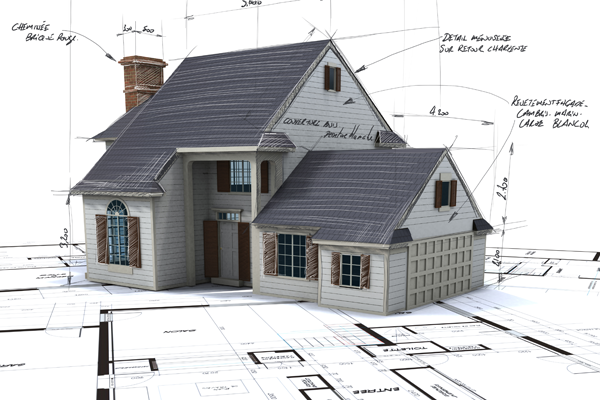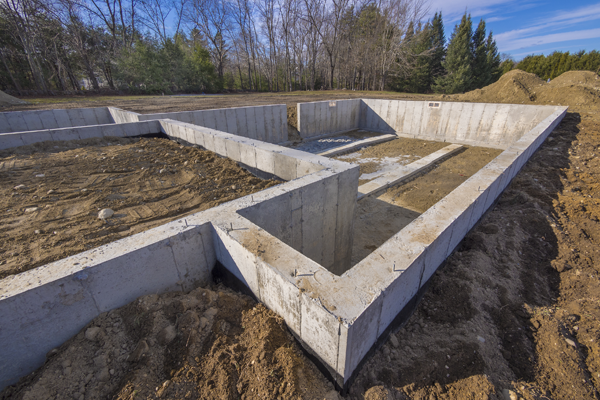New Construction Information

Find An Agent Before Meeting with Builder
Many builders will not allow you to hire your own agent if you wander into the new homes sales office without representation. If you visit a builder's home construction site without an agent, you might be hosed, because later the builder could refuse to pay your agent. Let your agent introduce you to the builder, and you're covered.- The builder's sales agents are paid to represent the builder, regardless of what they may tell you. Many will use high-pressure tactics to persuade you to sign the contract. Due to the high volume nature of brand new home sales, lots of builder's agents are paid less than a traditional commission; some earn a salary plus incentives, so turnover is important to their livelihood.
- Hire a buyer's agent to represent you. Most of the time, the builder will pay your agent, but sometimes the responsibility for the agent's fee is open for discussion. Builders generally advertise how much they will pay a buyer's agent. Rarely do they refuse, unless inventory is low and demand high. Even if you have to directly pay your agent, you can probably add that fee to the sales price, and it would be worth it because a good negotiating buyer's agent can save you thousands more than the commission.
- Your own agent will represent you and be your fiduciary, and he or she is required to disclose the positives as well as the negatives about the transaction. Builder's agents don't discuss drawbacks. Your own realtor is required to put your interests first.
- If your contract contains a contingency to sell your existing home before buying, hire your own listing agent to list your home. Be aware that buying before selling is not always in your best interest, because hard bargaining often goes out the window when you've emotionally moved out of your home.
Finding a Builder
Personal recommendation is always the best way of finding a builder. It's a major undertaking, and you want to make sure you have complete peace of mind from the start that the right builders are doing the job for you. Do your research. Ask friends, family and neighbor’s if they know of, or have used, reliable builders. Ask about the quality of the builders' workmanship, costs, and reliability, how long it took them to complete the job and whatever else you feel you need to know. Check online for reviews and get feedback from people who have used the builders before. Make certain the builder is fully, and correctly, insured for the job.
Check Out the Builder’s Reputation
- If a buyer has a bad experience with a builder, the word spreads rapidly throughout a community. But you won't know if a bad rep is an isolated experience or if the builder repeatedly brings bad publicity to itself without checking and verifying the public records for lawsuits.
- Talk to the neighbors and scrutinize the construction quality of surrounding homes. Is the builder consistently building an identical or larger house in the area or is construction lagging and homes shrinking in size?
- Find out whether the builder sells to investors. Some builders require all their homes to be owner-occupied. Others eagerly sell as much inventory to investors as profit margins will allow. If the market suddenly dips, investors are typically the first to bail and, besides, part of the reason you are buying in a new subdivision is to be surrounded by other buyers just like you, not tenants.
Choosing a Mortgage
Often time, builders and mortgage companies will partner in order to offer buyers assistance with down payment or closing costs. While this can be an attractive incentive, especially to first-time homebuyers, this option can come with a certain loss of control. Using the builder’s mortgage means that they have complete control over the pace of construction and ultimately the closing date, which gives them power to make financial decisions that benefit their position as seller. Ultimately, this will affect your ability to correct defects and address imperfections in a timely manner prior to your closing or “Celebration Walk”. Without any financial leverage, you are left defenseless and unable to force the builder to address or make certain changes prior to closing. Once the deed is transferred it will be extremely difficult to get the builder back to remedy any previous damage or issues unless they are warranty related.
In addition, a builder’s mortgage company will often sell your mortgage to another company that may not provide the same benefits to help you meet your financial goals. Ultimately, your best bet is to work with a local credit union to help you navigate these financial decisions and find mortgage terms that will work for you in the future.
New Construction Options
Buying new construction can cover a range of options. You could start by hiring an architect to design your home and then work with a contractor to construct a fully customized new build. Another option is a semi-custom home. In this case, the developer will offer several different models to choose from. While the floor plan is pre-determined, you will still be able to customize interior and exterior details to create a home that best suits your family, your lifestyle and your personal taste. Finally, you can opt for a completely pre-built home that has been designed and constructed by a production builder.Advantages of Choosing a New Construction Home
For most people, buying a home is the single biggest financial purchase they will make. Why settle for someone else’s choice of cabinets and flooring when you can have a home built completely from scratch and according to your specifications? You can personalize the layout, choose everything from the cabinet pulls to the light switches and create a house that truly feels like a home.Even with semi-custom homes, you still have a certain amount of freedom and choice when it comes to the details. You will be able to have your choice of finishes, appliances and fixtures. While certain finishes or upgrades can add to the cost of your home, it may be worth the added expense to create a final product that meets your needs.
While a pre-built doesn’t offer a lot of room for customization, it will still include a modern layout and you won’t have to worry about making repairs or updating old appliances or electrical and HVAC systems. Newly built homes can help you avoid problems and surprises. Afterall, everything will be brand new and ready for your family.

Choosing a Floor Plan
The right floor plan will accommodate your family and your lifestyle and influence how you experience and enjoy our home. With so much riding on the floor plan you choose, deciding can feel intimidating. To help you narrow down your choices, here are ten tips to choosing the right floor plan:- Decide how much space your family needs. Too much house can mean unused space and more time spent cleaning. Smaller footprints may be ideal now but won’t be enough down the road as your family expands. Think about how many bedrooms and bathrooms you will need for both your family and any regular guests. You will want to plan both for what you need now and what you might need in the future. Once you have a general size in mind, you can start making additional design choices.
- Find a floor plan that fits your design style. More traditional designs will feature rooms separated by walls so that different living spaces are compartmentalized. If you prefer modern design aesthetics, you may want to opt for a more open floorplan that allows traffic to flow more freely throughout the home.
- Consider the type of dwelling you want. Suburban locations are typically more single-family home friendly and allow for ample outdoor space. Urban areas might only be able to accommodate brownstones, condos or other attached homes. If you have a smaller lot, a split-level home may be able to provide you with more space by allowing you to build up vertically. The right dwelling will depend in where you are building and other types of houses in the neighborhood.
- Be willing to make compromises. You probably have a long list of wants but creating the perfect floorplan may not be possible and you will have to weigh the pros and cons of different design elements. For example, large picture windows may seem attractive, but they can also affect your privacy and utility costs. Prioritizing your “must haves” can help you make decisions more easily.
- Don’t get caught up in the details. It can be easy to be distracted thinking about all the finishing touches and lose sight of the bigger picture. Before you start worrying about carpets and hardwood floors, be sure that your space serves your family and your life.
- Work with a professional. A real estate expert or building specialist will have experience dealing with different design factors that you haven’t even thought to consider. They will be able to walk you through issues related to budgeting, energy efficiency, location and much more.
- Listen to your gut. Yes, there are a lot of designs to choose from, but your instincts may make the decision process easier than you think. Choose a space that feels comfortable and gives you a sense of home.
- Consider your existing furniture. If you want to avoid having to buy new furniture, you will want to take your existing furniture into account when planning the layout of your home. Be sure determine whether it will fit into the floorplan without making rooms feel cramped and crowded.
- Understand your budget. While it would be nice to be able to spend freely and create your dream home, most people have to take budgetary limitations into account. Before you fall in love with a floorplan, make sure that you know all of the costs associated with each option. You may even want to consult with a builder to avoid any surprises or hidden costs.
- Ask about the potential for modifications. You may be able to make modifications to floorplans in order to create a semi-customized final product. If you need more closet space or an extra window to let in more natural light, a builder may be able to work with you to make adjustments. Be sure to ask about the potential for modifications before making a final decision.

Planning a Home for the Future
As you go through the planning process, you need to keep in mind how your needs might change in the future while also considering the fact that you will probably be selling your home at some point. Making smart decisions now can mean that your home continues to grow and evolve with you and that you are able to go experience a smooth and hassle-free selling process when you decide to move. Here are some key elements to pay attention to that will set you up for the present and the future.- Don’t cut corners on your HVAC system. This essential component of the home significantly contributes to the overall health and comfort of your family. A poorly installed and maintained unit can lead to moisture and mold growth, which can undermine the integrity of your entire home. A system that is too small for your home can make it impossible to maintain a comfortable interior environment while an oversized unit will run up your utility bills.
- Use your space wisely. Storage is an essential part of any home, but you want to be smart about where you place closets so that there is a balance between living space and storage space. Be sure to add a spacious closet to each bedroom and a linen closet in the hallway. If you live in a colder climate that requires plenty of outerwear, you may want to expand the closet space in the front foyer.
- Include plenty of light. Every room should have as many windows as possible to provide plenty of natural light. There should also be plenty of light fixtures and conveniently placed outlets and switches. Well lit rooms can make a big difference in the look and feel of a home.
- Reconsider bonus rooms. While a playroom or theater room may sound exciting, these bonus rooms may not be the best use of space. Often times, these rooms are underutilized and end up being catch-all storage spaces. Instead of fully customizing a room and limiting its use, make sure that the space can be easily transitioned into a guest room or office that can be more utilitarian.
- Strategically place the laundry room. Every person has different opinions about the best location for a laundry room. Keep in mind that you might want it placed upstairs by the bedrooms or next to the mudroom for maximum convenience.
- Make the kitchen easily accessible. You may not want the kitchen to be the first thing people see when they walk in the door, but you also want it to be accessible so that you can carry in groceries and easily serve guests in the dining room. The kitchen also provides a path to divert traffic from main living areas, so be sure to take this into account as well.
- Place the bedrooms away from noise. You don’t want your master bedroom above the garage or next to main living spaces where you will be able to hear as people watch TV or come and go from the house. Placing the bedroom in the back corner of the home will allow you to enjoy peace and quiet.
- Place the garage next to the kitchen or a mudroom. Families usually enter and exit the home through the garage, which means that this area gets plenty of foot traffic. With everyone bringing in groceries, book bags, muddy shoes and heavy coats, you want the garage to be located next to an interior room that is easy to clean and provides a place to set down and store items. A mudroom with storage is a great solution, but if you are tight on space, the kitchen will also work as a functional compliment to the garage.
- Consult with a professional. Chances are that a professional designer has already encountered and solved some of the problems you are facing. They will be able to make expert recommendations and help you perfect the overall design of your home so that it serves you both in the present and well into the future.
Choosing a Lot for Your New Construction Home
Once you have made the decision to build a new custom home and gone through the process of hiring a builder and contractor, creating a budget and deciding on a floor plan, it is time to find the perfect place to build your home. Here are some key factors to consider when choosing a lot:- The Neighborhood:
- Proximity to Work and Amenities:
- Growth Potential:
- Noise:
- Traffic:
- Lot Placement:
- The Topography of the Lot:
- Visualize Your New Home on the Lot:
Take your time to tour potential neighborhoods. You want to make sure that you are going to enjoy living there. Drive around the area on different days and at different times. Pay attention to how the neighborhood looks during the day and at night. Observe activity levels and how neighbors interact with one another. For example, if you have a growing family and want a kid-friendly neighborhood, you want to see kids out playing in the yards.
Take into account how far you will have to commute to work and other locations. Is the lot close to your gym, church and other important places you frequent? How far will you have to travel to get to the grocery store, entertainment of other shopping areas?
Evaluate the area’s potential for growth. Is the neighborhood experiencing a lot of new construction or is it an older community that is pretty well established? If surrounding areas are booming with new businesses, schools and shopping areas, you can probably expect to be affected by that growth. This may be a plus for you or you may want to look for a lot in a quieter neighborhood that won’t be experiencing a lot of change in the coming years.
Is your lot close to a school, highway, railroad tracks or industrial area? Noise levels can affect your quality of life and the resale value of your home. Look for a lot that isn’t exposed to excessive or constant noise from surrounding buildings and roads.
Traffic can be a major concern as you consider commute times and the safety of your kids. Are you looking at a lot that is close to the entrance of the neighborhood? If so, expect to experience a lot of noise and traffic as people enter and exit the neighborhood.
You may want to look for a lot on a cul-de-sac to help eliminate through traffic and provide a safer place for kids to play. Just keep in mind that cul-de-sacs can be difficult for large vehicles to maneuver, which can make everything from snow removal to fire rescue more difficult. Lots along a cul-de-sac also tend to offer less front yard and parking space although this is often balanced out by a more spacious back yard.
Corner lots offer the advantage of more space and the potential for a side-loaded garage. This placement helps keep the garage out of sight and provides a cleaner façade. However, a corner lot also means traffic and sidewalks along two sides of your land. For those who have to deal with winter weather, this can mean additional snow removal responsibilities in order to clear both streets and sidewalks.
If you are considering building on a lot at a T-intersection or one that faces an incoming street, you will have to deal with headlights from oncoming traffic. Be sure to design a floorplan where the bedrooms are not facing the front of the house so that you don’t have to deal with lights keeping you up at night.
The natural and artificial features of your lot can affect your budget and building schedule. If the lot includes rocks and trees that will need to be removed, this can add onto the overall cost of building a custom home. Also, be sure that your builder examines your lot for utilities. If your lot hasn’t been prepared for plumbing and electricity, your builder will need to determine whether they will be able to connect your home. As you shop for lots, be aware that utility-connecting costs can range from $10,000 to $30,000.
Take the time to imagine your new home on the lot. Know the dimensions of your home so that you can clearly see the footprint on the land. How does it look? Will you have enough room to entertain guests outdoors or plant the garden you have always wanted? Are you too close to your neighbors? What views will you have from the house? What will be located beside and behind you? If you are building in a new development, how will your views changes as additional houses are built?
Every lot comes with certain advantages and disadvantages. Choosing the right lot comes down to your individual preferences and what you want out of your custom home. Take the time to consider different factors and locations and avoid feelings of buyer’s remorse down the road.
Dealing with a Homeowner’s Associations (HOA):
HOAs are common in planned communities and are designed to protect property values, maintain common areas and create a sense of community in the neighborhood. The HOA is run as a non-profit organization and works to both establish and enforce certain regulations. When you purchase a home in a neighborhood with an HOA, you are agreeing to the community rules.Those who fail to follow the rules may be subject to fines. That makes it important that you not only understand the neighborhood rules and regulations, but that you are willing to follow them. Otherwise, you may find yourself at odds over landscaping, parking or even home additions and renovations. It is up to you to do your research and determine whether an HOA will be the right fit for you.
Evaluating an HOA:
There are two main factors to consider when evaluating an HOA: what kinds of fees you will have to pay and the basic rules, which should be clearly outlined in a governing document. Every HOA comes with mandatory fees, which may need to be added to your monthly budget. The HOA fees may mean that some neighborhoods are out of your price range.
It is also a good idea to ask for a copy of the HOA’s budget so that you can have a clear understanding of exactly where your money is going. You will also want to see that the association has easy access to funds in the case of an emergency. Without money in reserves, you could end up paying even more if something goes wrong in the neighborhood.
Reading through the HOA’s governing documents will also give you a good idea about their priorities. If you agree with how funds are being spent and you can clearly see that the neighborhood is being well-maintained, you may have found a good fit.
In addition, it is recommended that you look into the history of the HOA and find out if residents have had to pay special, additional fees in the past and whether litigation has been necessary to resolve disputes. The HOA should be willing to provide this information so that you can make an informed decision.
Finally, take the time to talk to other residents and get their opinion about the HOA. They may be your best source of information.
Gathering all this information will help you decide whether the HOA is a good fit and help you avoid frustration and conflict once you are a homeowner.
Making Changes to Your Custom Home
Once your home design has been finalized and the building process is underway, instances may arise where you want to make changes to the original plan. Perhaps seeing a type of flooring in the actual room makes you question the finish or you find a kitchen backsplash that you like more than your first choice. In order to deviate from the building plan, you will have to go through a formal process known as change orders, which refers to anything extra that wasn’t included in the original bid. Here are some other common instances that may require a change order:- A designer finds a problem in the original plan and has to make changes to ensure a proper fit or build.
- A code inspector identifies an issue that must be corrected in order to pass inspection.
- Previously undiscovered conditions require additional work. For example, leveling ground and creating adequate drainage.
How Change Orders Work
A change order is a document that should outline the scope of the work request along with any additional costs and a final completion date. Keep in mind that additional costs associated with the change are usually due at the date of completion, so be ready to pay when the project has been finished. As a homeowner, you will want to carefully review the change order and make sure everything is correct. Check for any discrepancies with material price; unit or labor cost, and verify all selections are exactly what you picked out.
What to Look for in a Change Order
It is expected that a contractor will charge extra to make additions that require new material and affect deadlines, but you should not have to pay for details that were left out of the original bid. Most contracts will also specify that the owner does not have to pay for change orders that are agreed upon verbally. Only written orders can be charged for and they have to be approved by the homeowner before the contractor can proceed.
The best way to avoid dealing with change orders that are the result of mistakes or misunderstandings is to begin with a detailed plan that clearly outlines the scope of work. That also means partnering with a skilled contractor with integrity. While it may be tempting to go with the lowest bidder, they may be leaving out details that will add up and cause delays during the building process. If at all possible, it is also helpful to have a set of eyes such as a construction administrator watching the building process to make sure everything goes smoothly, and no detail is overlooked.

Why New Construction houses need to be inspected by private home inspectors
If you’re buying a new construction home, you might assume that a home inspection isn’t necessary. After all, you had the house built from scratch and customized to your exact needs and likings. No one else has ever lived there, and no time has passed for anything to break or go wrong.
A home inspection is a third-party evaluation of a home’s structure, systems, appliances and other important features. The inspector will evaluate your property, give you a report on all his or her findings, and you can then go to the seller (in this case the builder) to fix any desired issues before you close on the home. In a nutshell, inspections can help ensure you’re getting a safe and hazard-free property, that you’re making a good investment, and that you won’t have tons of repairs to make before move-in (or worse, right after it). If you own a new home and didn't have it inspected before you bought it, consider having it inspected before your one-year warranty is up. Builders should welcome the opportunity to have their homes inspected by private home inspectors; it's a chance for construction errors to be addressed before they become major problems. It doesn't matter how thorough the municipal inspector is; mistakes are still missed.
The Construction Process
As you begin your new build project, it is important to understand the basic construction process. Essentially, there are four main phases:
- Footers and Foundation: This first phase is perhaps the most critical as it lays the foundation for your home. Foundation walls must be built using the correct concrete with the right psi. It is also important to properly backfill walls to prevent cracking and other major structural problems. Don’t hesitate to ask your contractor questions about concrete curing times, bracing techniques and other technical issues as they tackle this first step.
- Framing: During this second phase, your home will begin to take shape. Any damage to the frame during this stage will affect the final product. That is why it is important to plumb walls and begin with a level structure.
- Mechanical: Perhaps the most important aspect of installing electrical and plumbing is making sure that you are choosing systems that are the right size for your home, both now and in the future. Be willing to spend more during this process so that you can save money on utility bills as you use your systems. You may also want to consider whether you will be finishing your basement or putting any additional demands on your mechanical systems down the road. It is easier to plan for the unexpected now than make major renovations in a few years.
- Finishes: This is where all the details start to come together. Everything from wall paint and flooring to tile and trim will be installed and your home is almost ready for move-in. Pay attention to your selections and always verify for inaccuracies on your selections sheet, there should be no surprises with selections made after they have been ordered or installed already.

Final Walk Thru/Punch Out
As you near the end of the construction process, it can be easy to become taken over with excitement and anticipation, but you still need to be diligent about paying attention to the details. This is your last chance to have the builder correct any scratches or cosmetic defects, so don’t get distracted. Start punching your new home out early. Develop a rolling punch list where items can be marked as complete and new ones can be addressed at the same time. Be sure to include the date, description, and a picture of the concern or issue. Once the punch item is resolved to enter the date it was verified as complete. Remember to keep an ongoing dialogue of concerns and issues with your builder as construction progresses, try not to wait until your final walkthrough to communicate everything. Its common items can be overlooked or even missed so plan to document everything at the time you find or observe it.
Warranties:

Once you have done the final walk through and signed off on your new home, the builder has little obligation to return and address any issues. Some builders will offer short, one-year labor warranties that cover any problems with workmanships. The material manufacturers will all have their own separate warranty certificates and some of these forms will need to be completed. While these warranties may sound like a good idea, they tend to be an upsell product that actually encourages you to sign off on the home. Your best protection against problems is a thorough inspection process followed by a detailed final walk-through. Corrections should be made before the final product is completed in order to eliminate the need for warranties.
11 Month Walkthrough:
Have you ever heard of a 11-month home warranty inspection? Don’t worry…most people haven’t. These are increasingly common, especially in places where new construction is growing at a rapid pace.
In its simplest form, a 11-month home warranty inspection is where an inspector conducts a full inspection before your warranty runs out. This way, if there is anything that needs to be fixed, the builder can take care of it on their dime, not yours.
Most people think that since their home is new, they do not even need a home inspection before they close. Let’s fast forward to your 11th month in your brand new home in paradise. You think that the door doesn’t latch properly to the outside, or some windows are not opening or closing as smooth as you would like. Hiring a home inspector lends instant credibility to your case for why these items should be fixed. The report the inspector delivers to you should be forwarded to the warranty department for their review.
It is in your very best interest to hire a home inspector to evaluate your home before you close and/or before your warranty runs out. Wouldn’t you rather have the builder pay for the repairs?
